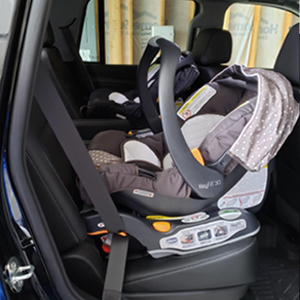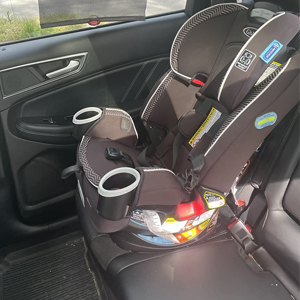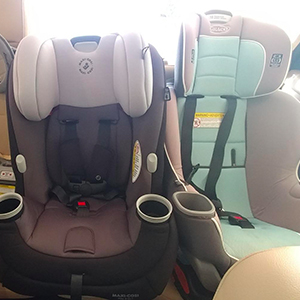According to the Minnesota State Law, children under 8 years old or less than 4 feet 9 inches in height should be secured in a federally approved child passenger restraint that is installed with seat belts based on the manufacturer’s instructions.
The child restraint system should meet the standards of the United States Department of Transportation. It can be a car seat or a booster seat.
No matter you’re a citizen or a passer-by, it’s better to follow the MN official legislature rules on riding with a child.
What is the Car Seat Law in Minnesota?
2021 Minnesota Statutes, 169.685 Subd. 5 (a) says: “Every motor vehicle operator, when transporting a child who is both under the age of eight and shorter than four feet nine inches on the streets and highways of this state in a motor vehicle equipped with factory-installed seat belts, shall equip and install for use in the motor vehicle, according to the manufacturer's instructions, a child passenger restraint system meeting federal motor vehicle safety standards.”
Minnesota State Legulations
Rear-Facing
Minnesota Rear-facing Car Seat Laws
Forward-Facing
Minnesota Forward facing Car Seat Rules
Booster
Minnesota Booster Seat Laws
Front Seat Laws
When can child sit in front seat Minnesota
Car Seats List
Best car seat to meet Minnesota laws
US Car Seat Laws
Seat Laws across the United States
MN Car Seat Laws Rear-Facing

The Minnesota law doesn’t say any age, weight, or height requirements for a rear-facing car seat.
It only requires that all children must be in a child restraint system until they are 4’9” tall, or at least age 8, whichever comes first.
However, the Minnesota Department of Public Safety (DPS for short in the following) makes it clear with rules that infants and toddlers should travel in the rear-facing car seat for as long as possible until they reach the highest weight or height set by the manufacturer.
MN car seat law is not that strict on rear-facing position. As a result, almost all infant car seats meet the rules for safely traveling newborns.
The Doona Infant and Stroller might be the best rear-facing car seat option to meet the rules in Minnesota.
Minnesota Forward Facing Car Seat Laws

When can a baby face forward in a car seat in Minnesota?
You can’t find any rules in MN law mentioning the time when a child can face forward in the car seat.
According to the Minnesota Office of Traffic Safety, children can travel in the forward-facing car seat once they reach the upper weight or height limit allowed by the car seat manufacturer.
The forward-facing car seat should come with a harness and tether. This is a common regulation suggested by National Highway Traffic Safety Administration. A 5-point harness reduces the injury for toddlers and preschoolers when they travel in the car facing the front.
Most forward-facing car seats, including the convertible, harnessed booster, and all-in-one car seats, allow up to 65 pounds for weight and 4 feet 9 inches for height. That typically happens when a child is 5-6 years old.
Graco Extend2Fit may be the best forward-facing option for the MN car seat law.
What is The Law for Booster Seats in Minnesota?

In Minnesota, according to 169.685 Subd. 5 rule (a) and (e) in 2021 Minnesota Statutes, children must be secured in a booster seat until they are 8 years of age or 4 feet 9 inches tall.
It seems the 8 years old is the booster seat age requirement in Minnesota, but this regulation is not stated in the laws.
The Minnesota DPS indicates that booster seats should be the safest option to travel a child after the child outgrows their forward-facing harnessed car seats.
It’s best to keep using the forward-facing car seat as long as the child outgrows the weight or height limit allowed by the manufacturer, the transition to the booster seat.
Seat Belt Laws for Child in Minnesota
There is no age, weight, or height rule for a child to use a seat belt mentioned in the MN car seat laws.
But the Minnesota DPS gives us the guideline – A child is ready to use the vehicle’s seat belt when the seat belt fits them properly.
How do you know if properly or not?
You can check if your child can sit with their back against the vehicle seat and have their knees bent comfortably over the edge with their feet touching the floor.
The best practice is to keep using the booster seat until your child approaches the top weight or height limit given by the manufacturer.
Most boosters, including harnessed, high back, and backless, allow 100-120 pounds and 57-63 inches in height. This typically happens at a child’s 8-12 years of age.
When can a child sit in the front seat in Minnesota?
Minnesota doesn’t have any laws or regulations for a child to sit in the front seat.
But the Minnesota DPS suggests the best safety tip is to keep your child sitting in the back seat when it is available.
Child safety experts and guidelines from NHTSA recommend a child younger than 13 years of age have a seat in the rear.
It’s not allowed to place a car seat in the front seat when the airbag is active.
Penalty for Breaking Car Seat Laws in Minnesota
From the Minnesota Legislature, 169.685 Subd. 5 rule, drivers who violate this law shall be fined up to $50.
Minnesota Car Seat Laws Apply for
The driver is responsible for child safety in motor vehicles. The law applies to
- All seating positions
- Both residents and non-residents of Minnesota
- All motor vehicles were originally equipped with factory-installed seat belts.
Exceptions
The law shall not apply to
- Emergency medical vehicles
- A peace officer in the performance of official duties and when a child passenger restraint system is not available
- Motor vehicles for hire, including a taxicab, airport limousine, or bus, but excluding a rented, leased, or borrowed car
- School bus
Taxi Car Seat Law in Minnesota
According to the 169.685 Subd. 6 rule, taxis are exempt from following Minnesota Child Restraint laws.
The parents should hold the major responsibility to ensure the child passenger’s safety in the car.
Does the taxi law apply to Uber?
That depends. If you’re a Uber driver and ride the parents with their kids, then it’s the parent’s duty to make sure the child’s safety. But if you’re going to rent a Uber car for self-driving with your child, the driver should be responsible for the child passenger’s safety in the car.
Age, Weight, Height Requirements in Minnesota Law
8 years old and 4 feet 9 inches tall are the only two numbers mentioned in the MN car seat laws for a child to use a child restraint or a booster seat. No more age, weight, or height regulations.
However, it’s recommended to follow the car seat manufacturer’s instructions and the guidelines from NHTSA to secure your child in four stages
Further Information
What you Need to Know – Four Car Seat Stages
Best Car Seats to Work with Minnesota Laws
Based on the Minnesota child car seat laws, here are the best car seats that will ride your boys or girls safely without breaking the rules.
To help parents quickly find the best option based on your child’s current age, this list is made by age.
Newborn - 2 Years Old
Rear-facing car seats
Birth - 4 Years Old
Convertible car seats for use
4-8 Years Old
Booster seats for use
With Special Functions
Car seats with Unique Features
Birth - 2 Years
30-lb rear-facing maximum weight
35-lb rear-facing maximum weight
Further Information
40-lb rear-facing maximum weight
50-lb rear-facing maximum weight
Further Information
Birth - 4 Years
65-lb forward-facing maximum weight
49-inch forward-facing maximum height
Further Information
Further Information
4-8 Years
100-lb booster maximum weight
120-lb booster maximum weight
57-in booster maximum height
63-in booster maximum height
Further Information
Further Information
- Best to Fit 3 Across – Diono Radian 3R
- Best with backless booster – Graco 4Ever DLX

The Diono Cambria 2 XL combines a highback and backless booster into one. It provides spacious room for growing big kids.
Diono Cambria 2 XL
- Weight Range: 40-120 lb.
- Height Limit: 63 in.
- Lifespan: 8 years
- Type: Booster
- Stage: 3rd
- Suitable for: 4-10 years old
The Good
- Up to 120 lb weight limit for big kids
- Up to 63-inch height limit
- XL size for roomy space
- Two modes for booster
- 8 years of lifespan
The Bad
- Can’t be installed on airplane
- Not fit 3 across
Car Seats with Unique Functions
For Travel
- Doona infant car seat stroller (with wheels)
- Evenfloy Shyft DualRide (wheeled car seat stroller combo)
Further Information
Slim Fit to Do 3 Across
- Diono Radian 3R and Radian series (17″)
- Evenflo Revolve360 Slim (16.75″)
Car seat with 5-point harness
- Britax One4Life (120 lbs/ 63”)
Further Information
Further Information
Resources
- Minnesota State Legislature on Passenger Restraint System for Children.
- Minnesota Department of Public Safety on Child Passenger Restraint Law.
